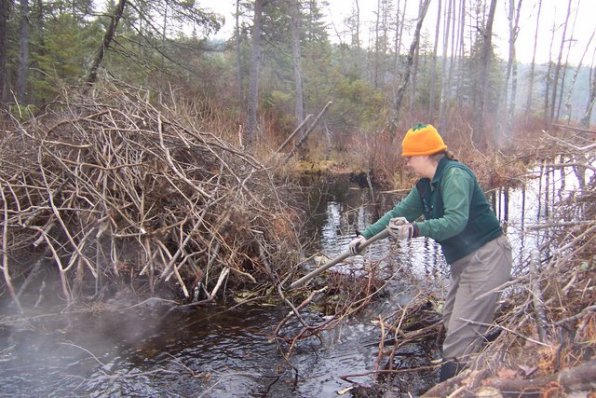“This will be the 27th time for me to break up this beaver dam so far this year!” declared Hilary Thomson as she used a rake to tear up the dam built by beavers at the outlet of Snow Pond. Her house is on the shore of Snow Pond in East Concord, and she said, “This dam raises the pond's water level just enough to flood my back yard!”
Thomson, who taught science at Concord High School for 22 years, is now retired and has more time to devote to her beaver problem.
Beavers change their environment more than any other mammal. They dare not go too far from the protection of water to cut down trees, so they take the water to the trees by building canals or raising the water level. As winter approaches, if they have no shelter they build one. Their lodge, which has an underwater entrance, has two compartments. One is a mud room where the beavers clean up and dry off after a busy night's work. The other is at a higher level where the beavers sleep and care for their kits.
When the first European settlers arrived on our shores, the beaver population was about 60 million. The early exploration of North America was driven by the quest for beaver furs which were sent back to Europe for making garments. By the early 1900s beavers were trapped almost to extinction but have since made a healthy comeback. Ellen Macneil of Chichester, administrative secretary for the Wildlife Division of the New Hampshire Fish and Game Department, said, “During the 2010-11 trapping season a total of 3,617 beavers were trapped in our state; of this number, 1,474 were trapped by wildlife control operators.”
Bill Bailey of Boscawen is a member of the New Hampshire Trappers Association. He said there is no limit on the number of beavers a trapper can take in a season and that a trapper will get about $16 to $18 for a good beaver pelt.
Beavers have been known to cut down trees 4 feet in diameter with their chisel-like teeth that never stop growing. One claw on each of the beaver's hind webbed feet is split and is used as a comb in grooming its fur and raking out harmful parasites. Also, it uses oil from a special gland at the base of its tail to keep its fur water proof.
When I was canoeing one evening near a beaver lodge, I heard a sound like a big stone being dropped in the water. It was a beaver giving an alarm signal by smacking the surface of the water with its powerful tail. Well adapted for life in the water, the beaver can stay submerged for as long as 15 minutes.
The largest rodents in North America, at times weighing up to 50 pounds, beavers are not looking for a fight. They show an excellent capacity to get along while living close to each other in a confined space. A Native American word translated “beaver-like” was used to describe a person who is congenial and friendly.
There are two beaver lodges on Snow Pond. When the pond is frozen over this winter, the beavers will suspend work on perpetually repairing their dam. That is when Thomson will no longer be a problem to them – until next spring.






















